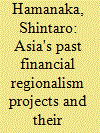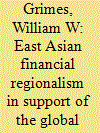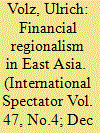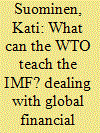|
|
|
Sort Order |
|
|
|
Items / Page
|
|
|
|
|
|
|
| Srl | Item |
| 1 |
ID:
141737


|
|
|
|
|
| Summary/Abstract |
In recent years, financial cooperation within ASEAN Plus Three (APT) has made significant progress. It has covered bond market development, better access to financing, financial stabilization and capital market harmonization, and several initiatives have resulted in concrete programmes being implemented by the APT member countries (ASEAN states, China, South Korea and Japan). In the context of the changes taking place in the regional dynamic, this paper examines the role and involvement of Indonesian financial authorities towards the development of APT financial regionalism, focusing on issues related to regional liquidity arrangements and regional bond markets. The initial findings indicate that, in considering the potential benefits of warding off future economic shocks, there is a strong intention among Indonesian financial authorities to create a space in their national framework for regional liquidity arrangements. However, the authorities are unenthusiastic about the progress of regional governance on bond markets and, for that reason, are disinclined to transform their national regulatory space as it potentially hampers the Indonesian domestic market.
|
|
|
|
|
|
|
|
|
|
|
|
|
|
|
|
| 2 |
ID:
105313


|
|
|
|
|
| Publication |
2011.
|
| Summary/Abstract |
This article analyzes five significant institutional variables related to membership and control of institutions, using comparative case studies of Asia's past regional financial projects from the 1950s through the 1990s. The five variables are: (i) countries included in or excluded from membership, (ii) membership tiers, (iii) institutional decision-making process, (iv) executive positions at organizational structure (e.g. secretariat and headquarters) of institutions, and (v) the location of the secretariat/headquarters. Past financial regionalism projects hold several important lessons for current initiatives. First, in the case of regional financial institutions, "inclusion in membership but exclusion from regional membership" is a possible option and it is crucial to go beyond the simple debate on the membership problem, namely inclusion and exclusion, when designing a regional financial institution. Second, no single country should dominate the decision-making process by voting power-an institution must maintain a delicate balance among its members in terms of voting. And finally, key to determining the success or failure of regional financial institutions is which country hosts the secretariat/headquarters and sends staff to the executive positions.
|
|
|
|
|
|
|
|
|
|
|
|
|
|
|
|
| 3 |
ID:
075471


|
|
|
|
|
| Publication |
2006.
|
| Summary/Abstract |
East Asian financial regionalism has advanced significantly since the rejection of Japan 's Asian Monetary Fund proposal in 1997. Key ASEAN+3 initiatives include the Chiang Mai Initiative, which is designed to provide emergency liquidity to economies experiencing currency crisis, and the Asian Bond Market Initiative, which seeks to develop regional bond markets. Surprisingly, these initiatives-despite the assertive "regionalist" rhetoric that has surrounded them and their intellectual origins in the analysis of the 1997-1998 Asian financial crisis-are explicitly designed to complement existing features of the global financial architecture, including IMF conditionality and global financial standards. The nesting of East Asian financial regionalism within the global financial architecture results from the political-economic interests of the leading economies of the region. In the absence of a major change in the political-economic environment, nesting is a stable equilibrium and is unlikely to change.
|
|
|
|
|
|
|
|
|
|
|
|
|
|
|
|
| 4 |
ID:
117711


|
|
|
|
|
| Publication |
2012.
|
| Summary/Abstract |
This article provides an overview of the current state of financial regionalism in East Asia and discusses why and how the East Asian countries should go forward in terms of financial and monetary regionalism. It highlights intra-regional exchange rate stability as an important regional public good and makes the case for greater exchange rate cooperation. To this end, East Asian countries should gradually reduce their exposure to the US dollar and move towards currency basket regimes which would sustain relative intra-regional exchange rate stability while allowing for sufficient flexibility to accommodate idiosyncratic shocks. Against the backdrop of the global and European financial crisis, the article also urges a reconsideration of the costs and benefits of international - and regional - financial integration and calls for a further strengthening of East Asia's regional financial architecture.
|
|
|
|
|
|
|
|
|
|
|
|
|
|
|
|
| 5 |
ID:
117710


|
|
|
|
|
| Publication |
2012.
|
| Summary/Abstract |
Despite rising back to prominence during the global economic turmoil, the International Monetary Fund remains under severe pressure over its lack of legitimacy and effectiveness. It is surrounded by increasingly vibrant and potentially competing systems of regional financial arrangements. But while it is feared that regional arrangements can undermine the global financial order, they can also help buttress the multilateral institutions that are struggling to manage an increasingly complex global economy. The purpose of this article is to draw on trade, exploring the decades-long efforts to ensure compatibilities between regional trade agreements and the multilateral trading system, to offer lessons to financial policymakers.
|
|
|
|
|
|
|
|
|
|
|
|
|
|
|
|
|
|
|
|
|